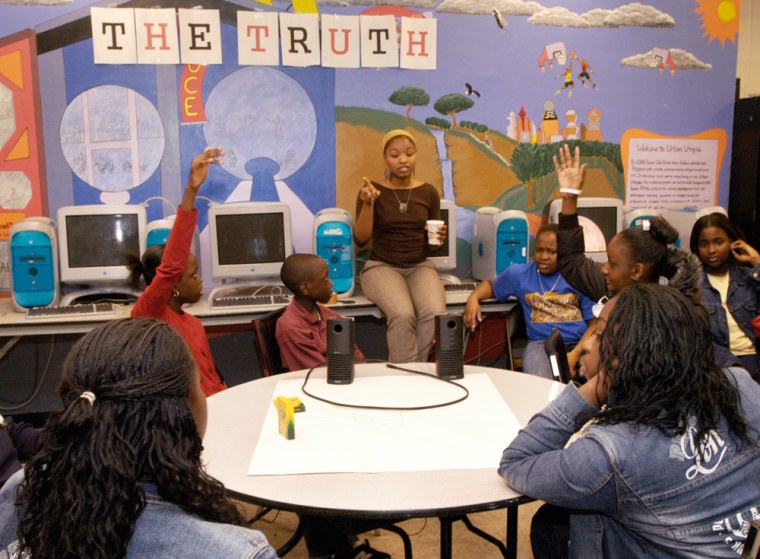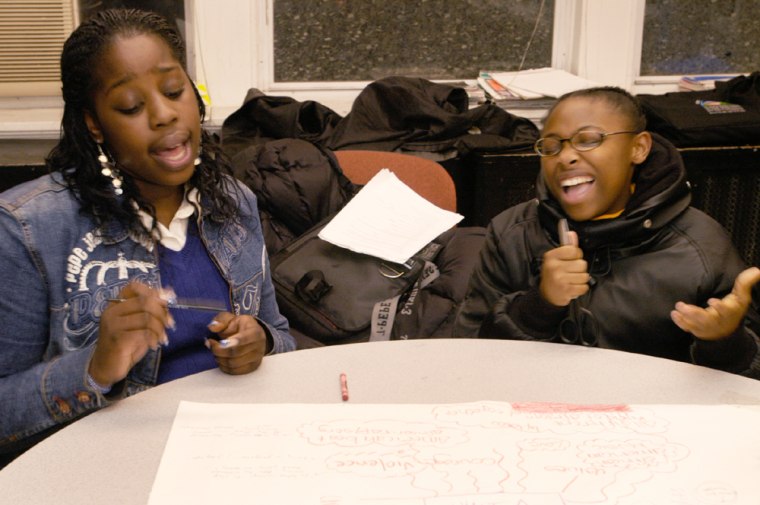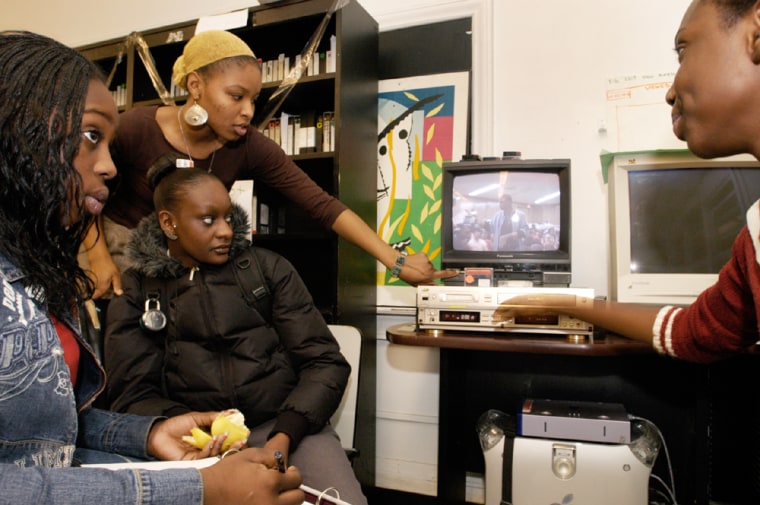Daba Diakhate talked about her life as an African immigrant in Harlem.
“They used to throw rocks at me, they used to throw sticks at me. They used to try to jump me," the 17-year-old said. "One time they tried to take my sneakers, but they realized they weren’t name-brand, so they were like, 'Here, take your Payless sneakers,'” she said, to the jeers and laughter of her fellow students at the Umoja Media Project, a gathering of of black Americans and African and Caribbean immigrants.
For Diakhate and many other immigrants, the area around 116th Street in Harlem is a sanctuary, their little West Africa.
As vendors and customers stroll through the Malcolm Shabazz Market, greetings are more often exchanged in West African dialects than in English. Men wear traditional prayer robes, and women sport colorful fabrics cut in African styles that would be more familiar on the streets of Dakar than New York.
The shops and restaurants that line the street cater to a West African clientele. The Baobab Restaurant serves up hot thiebu djen — a traditional Senegalese meal of rice and fish stew — and the Harlem Phone Card and Communication shop sells inexpensive phone cards to call home.
But while 116th Street may offer a sense of comfortable familiarity, the rough streets are not too far away.
According to the participants in Umoja, the predominantly black American neighborhood has not always been welcoming to the wave of African immigrants, whose numbers have jumped from 42,000 in 1990 to 92,000 in 2000, according to the U.S. Census Bureau.
That is what the project seeks to address. Organizers want to resolve the tension, misunderstandings and misconceptions that have sometimes characterized the relationship between black Americans and the recent immigrants.
Umoja Media Project
It began after the attacks of Sept. 11, 2001, a time of increased tension between the traditional black American residents of Harlem and the recent African immigration population, many of whom are Muslim.
As part of the larger nonprofit agency known as the Harlem Children's Zone which offers an array of education and social service programs, the Umoja Media Project was given a grant to create a documentary film that explores the relationship between the two groups.
“Umoja” is a Swahili term for “unity,” and the project now involves 16 students between the ages of 10 and 17 who meet twice a week after school at TRUCE, the youth development arm of the Harlem Children’s Zone.

At the TRUCE center on 118th Street the children have access to numerous computers and state-of-the-art video-editing technology to work on their documentary. The group is a mix of boys and girls who are the children of African and Caribbean immigrants born in this country and black American students.
When the group began, it discussed issues of of identity and stereotypes. Trying to work through labels like "African," "African-American," and "Black American" took hours of conversation. Eventually the group began to take their conversations about community, identity, and culture out on the streets of Harlem and began filming their documentary.
The children of recent African immigrants are often picked on at school because they are seen as different from their classmates. They are made fun of because they speak with a different accent, have darker skin, wear different clothes, and are told that Africans smell.
Nassou Camara, a 15-year-old 10th-grader whose parents hail from Senegal and the Gambia, told a story about what happened to her one day when she wore a necklace with a charm in the shape of the African continent around her neck. Another student said to her rhetorically, “You’re not going to bring no disease here, right?"
Chika A. Onyeani, publisher and editor in chief of the African Sun Times, a weekly newspaper that caters to the African immigrant population in this country, said it was important to break down stereotypes.
“There is no doubt that there is always some kind of disconnect between the two groups — a lack of communication — but different organizations and the media need to try to bridge that gap,” Onyeani said. “There will always be this angst, because there are just little crumbs that are left to us [the immigrant community] to fight for.
“But, there is more understanding and awareness now among teachers and parents. So, the stereotypes are not as commonplace as before,” Onyeani said.
In-between world
Still, many of the students involved in the Umoja project are stuck in a weird in-between world in terms of their identity because their parents don’t necessarily understand the harassment they receive at school and are resistant to them becoming more like their American contemporaries.
A number of them said that when they returned to Africa with their parents, they were equally confused in terms of their identity.
Nassou Camara explained that when she and her twin, Amanata, returned to The Gambia and Senegal with their parents a few years ago, it only compounded the idea of feeling like she was stuck between two different worlds.

“I feel like when I’m in America, I’m too African; when I’m in Africa, I’m too American. So I just feel like I’m in the middle, but I’m African American, I know who I am.”
African Sun Times' Onyeani, applauded the students' efforts to educate their American counterparts but also emphasized the importance that they know where they come from.
“You have to teach your children that they have to be responsible to their family back home — that if they send back even $50 it will help a lot of people," said Onyeani. "You can’t just say that we have a nuclear family —– because, of course, in our culture you don’t have ‘brothers’ or ‘sisters'; we are all related."
Lessons learned
For Tene Howard, 25, the former program coordinator for the Umoja project who now heads up all of the youth programs for TRUCE, giving the young people a forum to speak about the difficult line they are treading is huge progress.
As the child of immigrants from Guyana,she can empathize with the struggles her students are going through and the organization has helped many of them negotiate that difficult terrain.
“I learned to have pride about where I come from. Not to be scared to say I’m African and to have a lot of confidence to tell people I’m African,” said Amanata Camara. “I think Umoja had a big role and has made me more confident and it taught me things I didn’t know before about my culture.”
For Daba, the oldest sister of the Diakhate clan, Umoja has taught her to be “more calm” and not fight back when she is made fun of in school or some of her younger siblings are teased on the street.
The students are now working to complete their documentary. They have already begun showing it to different groups — they have shown it to a youth group associated with the local police precinct and violence prevention workshop for young third- and fourth-graders.
Their goal is to complete it and use it as a tool to bring their message of tolerance and understanding to a larger audience.
